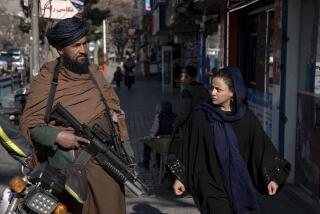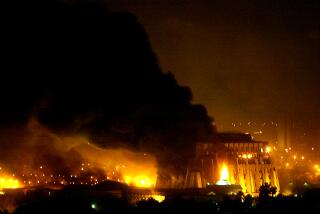The Enemy’s Shock and Awe
- Share via
“Shock and awe,” that jarring conjunction of trauma and wonderment, was the Pentagon’s original strategy for a quick victory in Iraq. A blizzard of cruise missiles would crash down on Iraq’s command-and-control nodes in a dazzling display of explosive firepower that would paralyze the enemy’s leadership. Now, however, it is the ongoing kidnapping and beheading of civilians and the widespread dissemination of pictures and videos of these brutalities that instead shock us.
The brutal drama of these decapitations tightly follows the discipline of the three-act structure more closely than most Hollywood films. First, the captive is displayed. Next, he desperately pleads for his life in exchange for some accommodation to the militants’ demands. Finally, when there’s no bargain and the deadline passes, the victim is slain in a barbaric, brutal manner: beheaded.
The term “beheading” evokes a false image of a single, swift blow. It does not capture the actual savagery of the acts perpetrated by the terrorists, in which a living man’s head is sawed off over long, agonizing seconds. As captured on video, the nightmarish scenes have been accompanied by an equally horrific soundtrack, the perverse admixture of the perpetrators’ repeated chant of “Allah Akhbar” (God is great) accompanied by the victim’s bloodcurdling screams. In the revolting climactic scene, the victim’s severed head is typically held aloft by its hair and displayed to the camera.
Despite the prevailing American popular culture of movies, television and music saturated with violent images, this ancient form of killing pierces through our hardened shell of indifference. We instinctively recoil because, by gratuitously violating a human being’s bodily integrity, the perpetrator violently expresses his contempt not merely for an individual’s beliefs or politics but for his fundamental humanity. Also, we see ourselves in the frightened victims. These are not battle-hardened soldiers trained to accept the perils of combat. These are ordinary workers employed in the most mundane of activities.
Beheadings have a long history across almost all cultures. The Bible has two famous references to it: David’s beheading of Goliath after striking him with a stone from his slingshot, and John the Baptist’s beheading at the order of Herod to keep a promise to Salome. British history contains many such executions, including King Charles I; Anne Boleyn; Mary, Queen of Scots; and Sir Walter Raleigh. France introduced the guillotine, and its most famous victim was Marie Antoinette. Japanese samurai culture included a highly ritualistic form of assisted suicide, known as seppuku, whereby self-disembowelment would be followed by beheading by a trusted friend.
The history of friction between Western empires and the Islamic world is replete with examples of beheadings. In 1842, Afghan forces overran the British garrison in Kabul and beheaded an estimated 2,000 soldiers. In 1885, British Gen. Charles Gordon was decapitated in Khartoum following a 10-month siege of the city by an army led by Muhammad Ahmad. In more recent clashes, Soviet troops were subject to beheadings during their occupation of Afghanistan in the 1980s. In the current conflict in Chechnya, Chechen rebels frequently behead captured Russian soldiers.
The original split between the Shiite and the Sunni sects, now a flashpoint for a potential civil war in Iraq, was precipitated by the beheading of the Prophet Muhammad’s grandson, Hussein bin Ali, in Karbala in 680. His tomb, among the holiest shrines for Shiites, was the scene of recent fighting between U.S. Marines and forces loyal to cleric Muqtada Sadr.
The wave of current attacks on civilians began in Pakistan in 2002 with the kidnapping of reporter Daniel Pearl, who was targeted for being both an American and Jewish. His wife appeared on television pleading for her husband’s release. “If somebody has to give their life to save him,” she said, “I’ll do it. Please get in touch with me.” She was six months pregnant at the time. In one of the pictures released by his captors, Pearl, in a quintessential act of American defiance, discreetly but unmistakably raises his middle finger to the camera. Days later a gruesome video of his beheading would be released. His body would eventually be found, cut into 10 pieces.
There is an Arab proverb that victory is gained not by the number killed but by the number frightened. As employed by the militants in Iraq, beheadings are a weapon of mass destruction, aimed at destroying our will rather than targeting our forces in the field. It remains to be seen if the American response will be one of revulsion and retreat or whether it will arouse greater support to defeat a gruesome and implacable enemy.
More to Read
Only good movies
Get the Indie Focus newsletter, Mark Olsen's weekly guide to the world of cinema.
You may occasionally receive promotional content from the Los Angeles Times.









